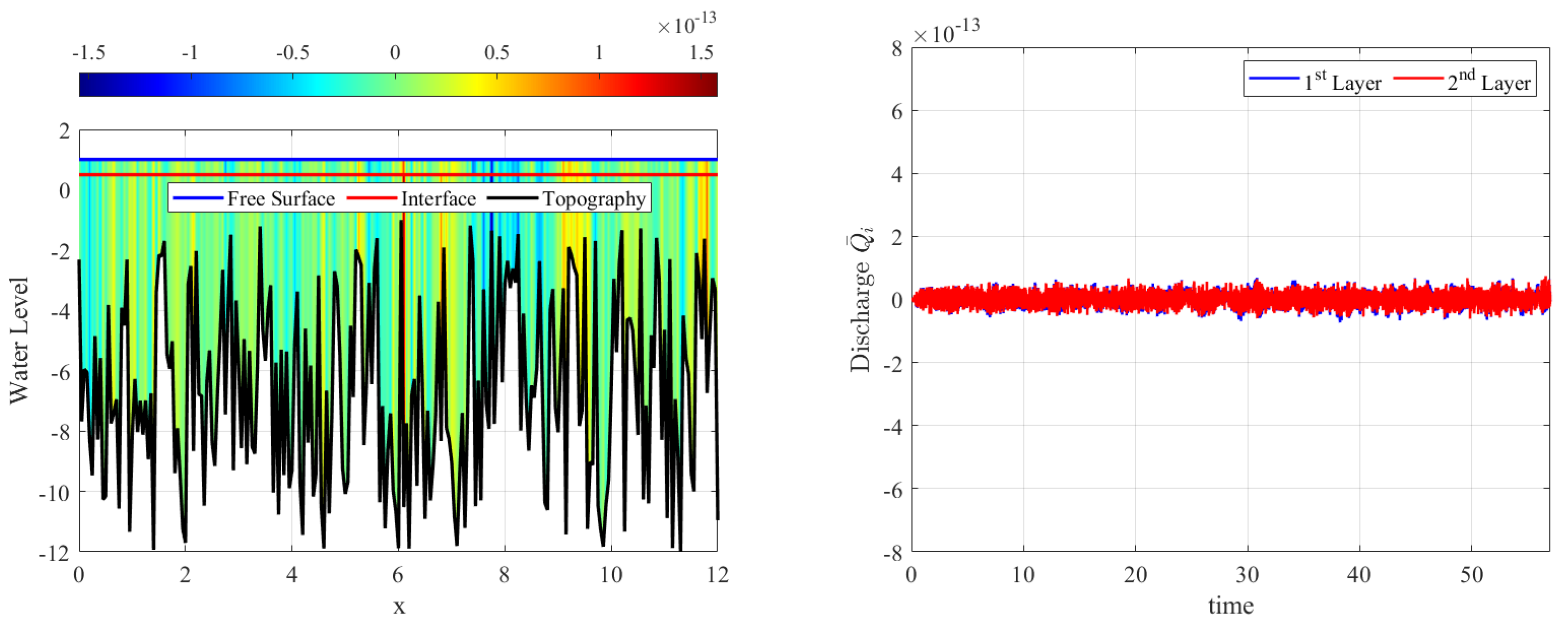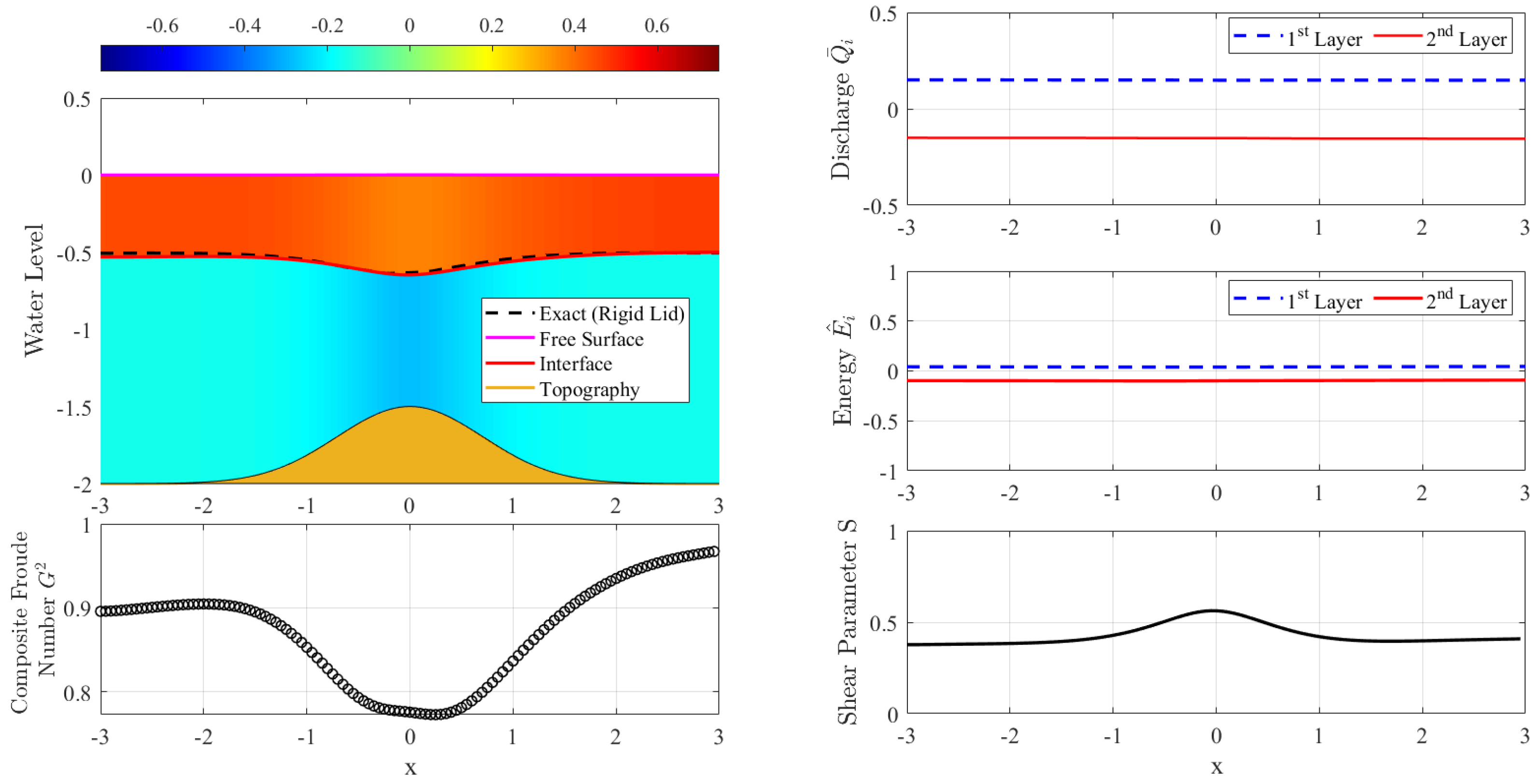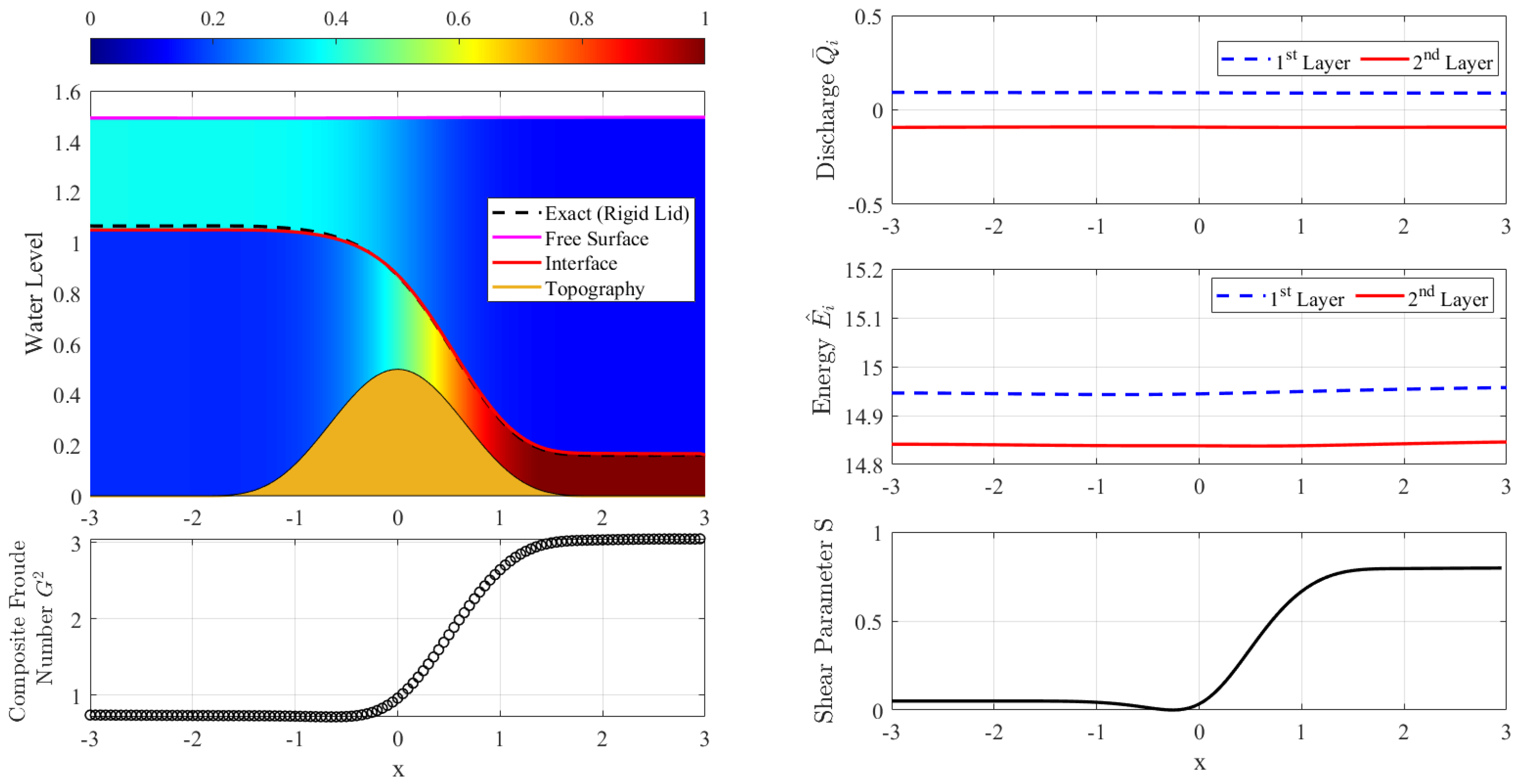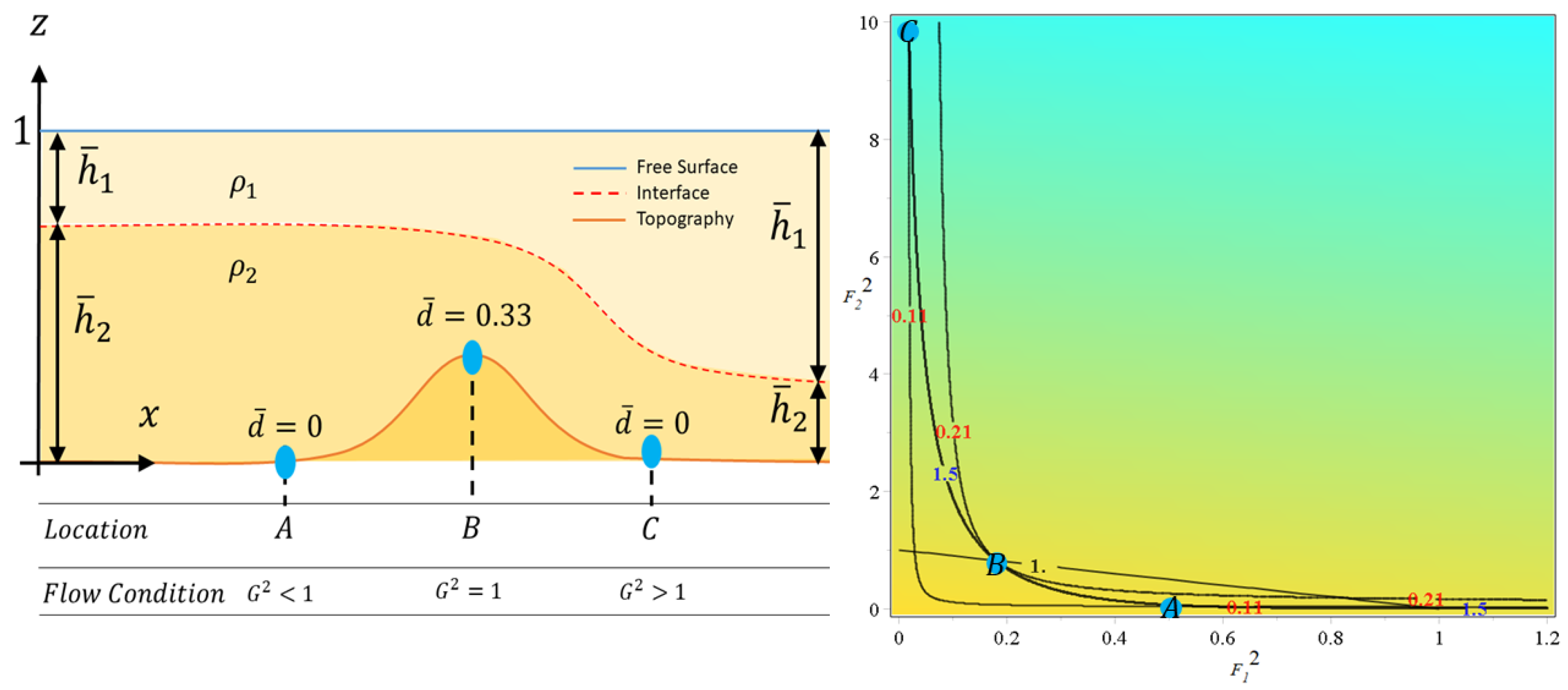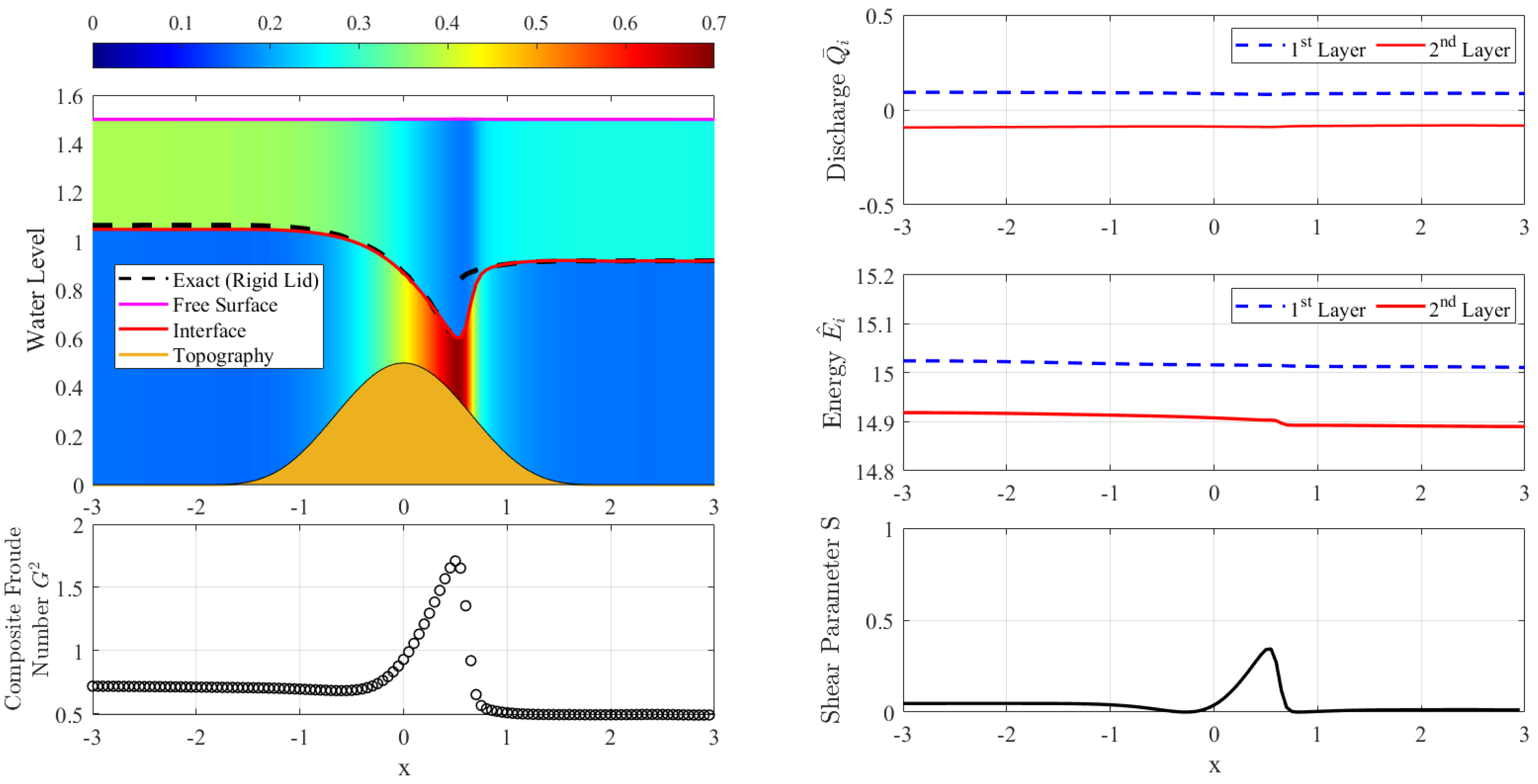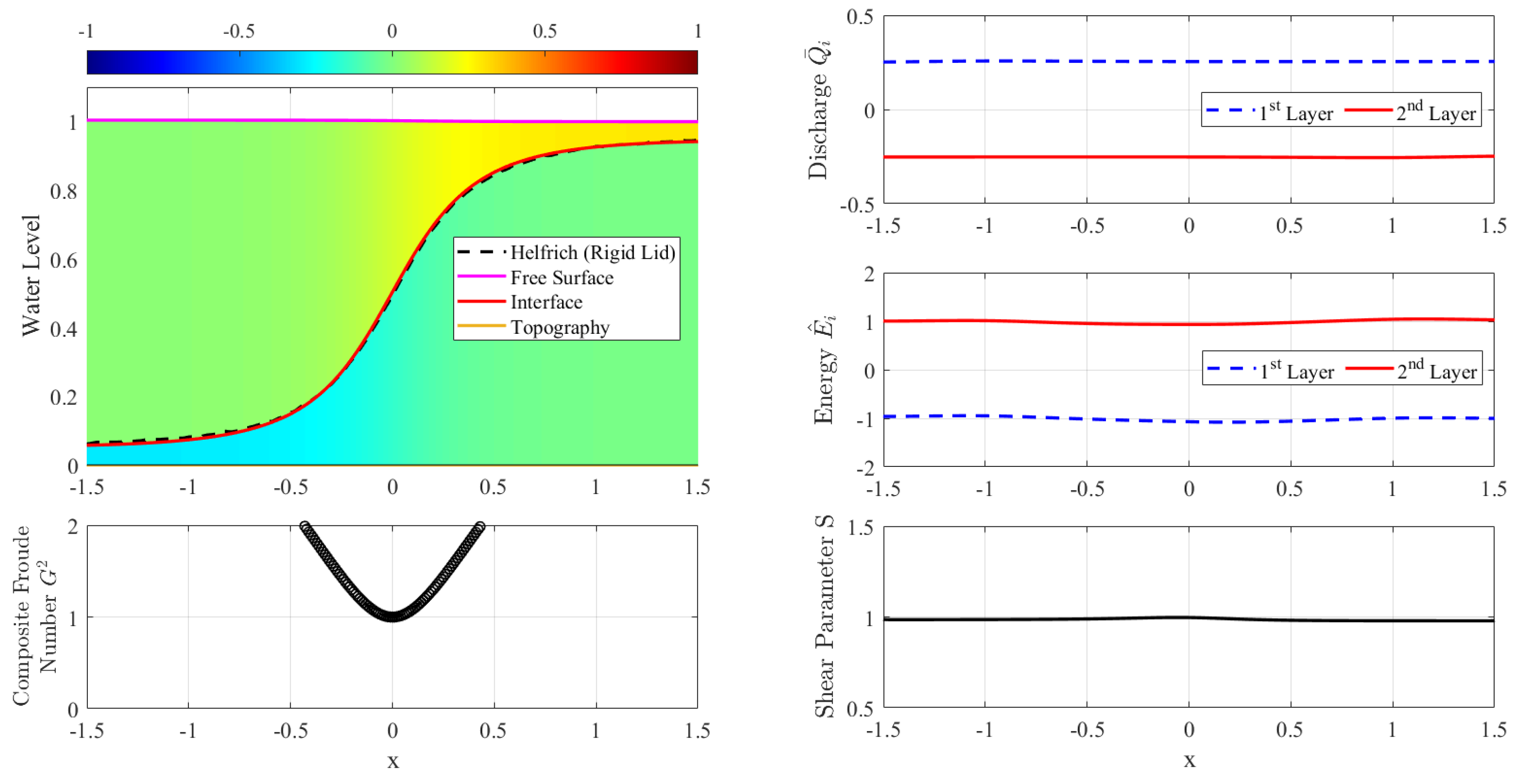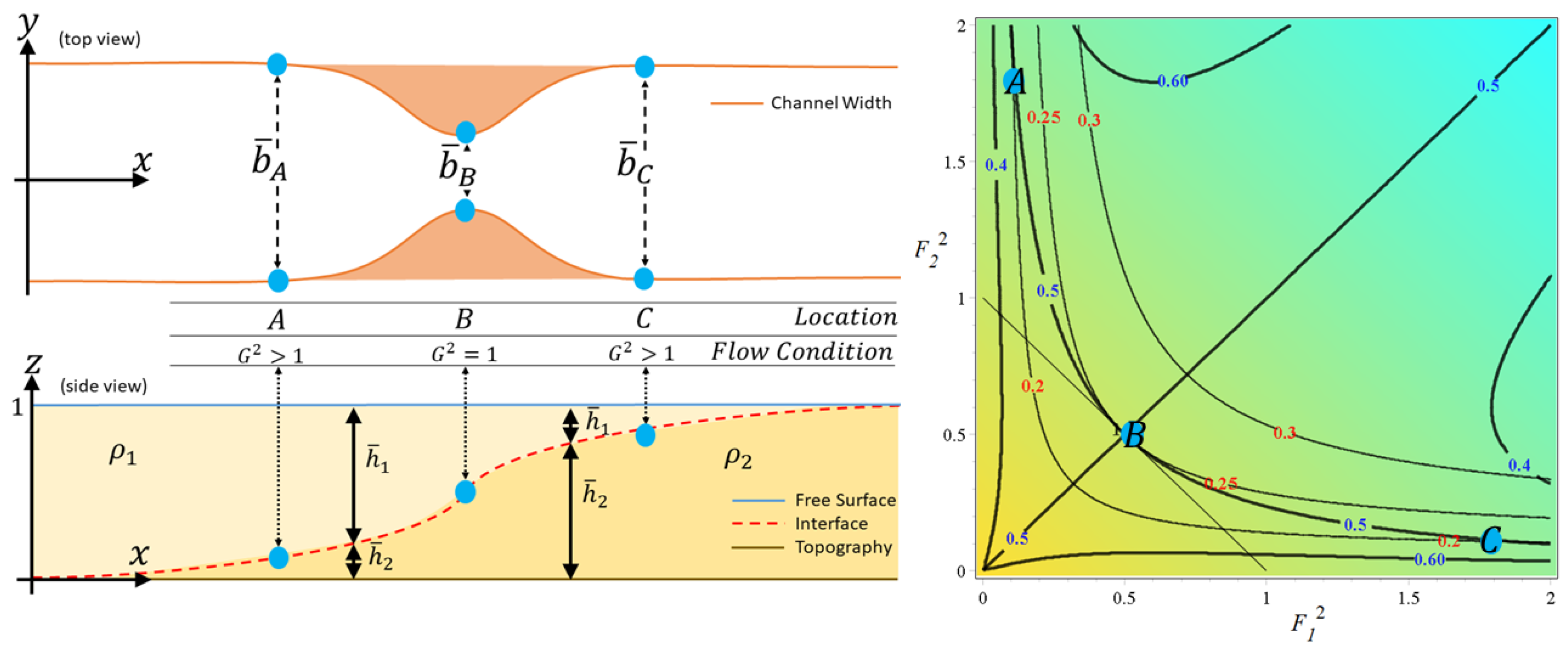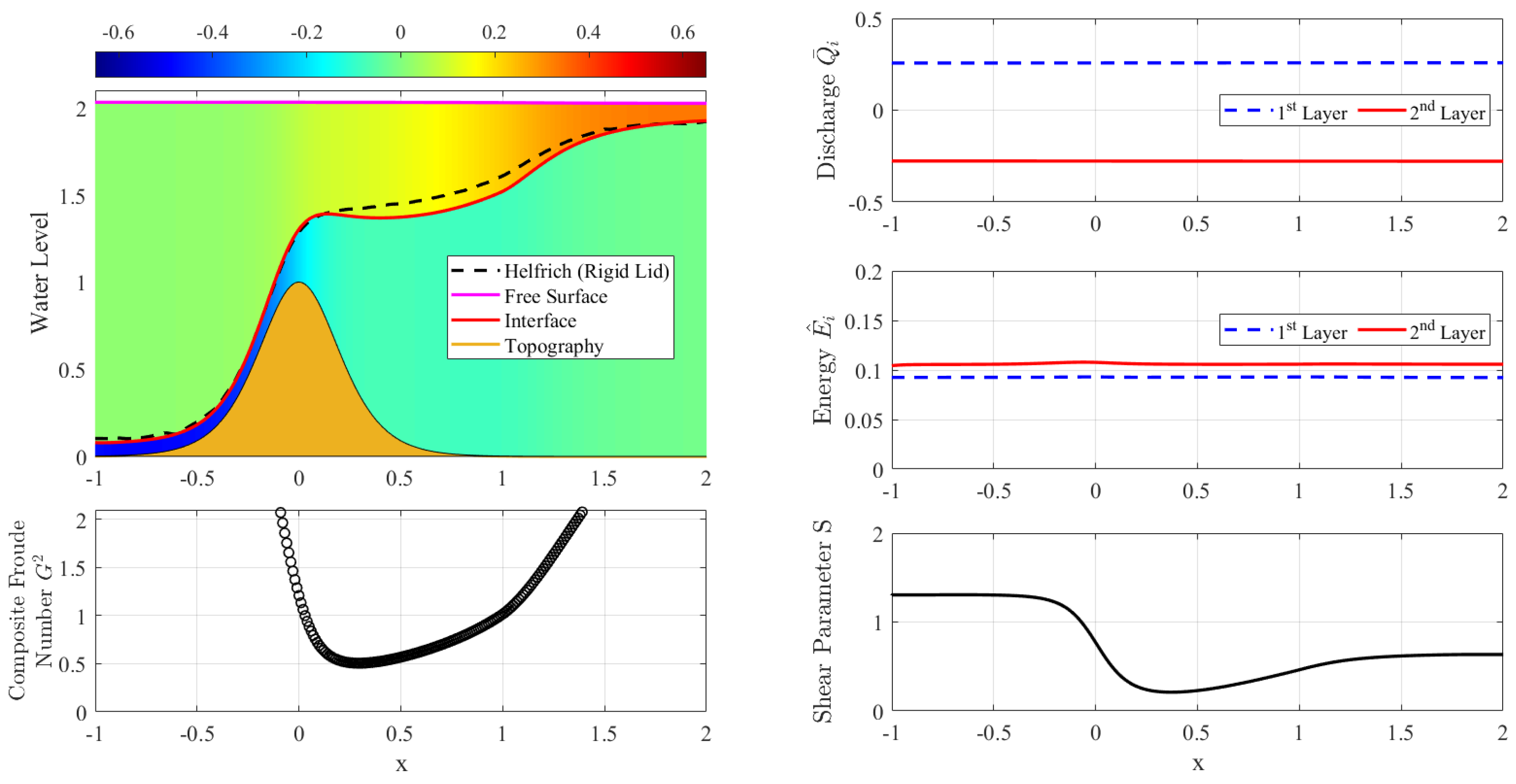1. Introduction
The presence of internal waves in Indonesian waters such as the Lombok Strait and the Andaman Sea inspired this research. The internal waves in the Lombok Strait form when a layer of warm low-salinity water from the Pacific Ocean enters the strait and flows into the Indian Ocean as part of the Indonesian throughflow (ITF); the complex bathymetry of the strait with a sill also contributes to internal wave generation in Lombok Strait. These internal waves, once generated, travel through the strait; after leaving the strait’s mouth, the wave propagates radially across the ocean, to the north of the Flores Sea, and to the south of the Indian Ocean.
In order to construct a numerical model for simulating the generation and propagation of internal waves in natural straits, we must begin with a simpler numerical model that captures the most important behavior of exchange flows through channels connecting two basins with different hydrological characteristics, such as the Lombok Strait. Several researchers [
1,
2,
3] and many others discuss the generation and propagation of internal waves in the Strait of Gibraltar. They adopted a one-dimensional two-layer shallow flow model, which can be applied to channels of varying topographies and widths, to model the influence of external flows in the strait. This one-dimensional approach is considered to be quite feasible for modelling the internal hydraulics of the strait and its effect on exchange flows [
3,
4,
5]. While internal wave propagation in the radial direction across the ocean requires a higher dimensional approach (two-dimension or even three-dimension). Inspired by their research, in this article, we will focus on developing a numerical scheme for a one-dimensional two-layer shallow flow model as well as testing the ability of the numerical scheme to simulate the steady interface of the two-layer fluid flows.
The goal of this research study is to investigate the dynamics of flow through a one-dimensional channel connecting two reservoirs. Our method employs numerical simulation of a steady interface in a channel with varying bed and width. In this paper, we present a numerical model capable of simulating steady interfaces in a variety of situations. In contrast to the one-layer shallow water equation, the two-layer shallow water equation model is not always hyperbolic [
1,
6,
7,
8,
9]. This presents its own challenges for the proposed numerical scheme. So far, the majority of numerical schemes that have been developed are associated with the finite volume or the finite difference methods. A numerical scheme based on a Riemann solver is proposed and developed by [
3,
9]. A finite difference scheme for solving the two-layer rigid-lid model is developed in [
1], whereas a phase resolving numerical model is described in [
2,
5]. References [
2,
5] developed a numerical model capable of describing dispersive waves. In this article, we will develop a numerical scheme for solving the two-layer shallow water equations. The scheme is an extension of the momentum conserving staggered-grid scheme (MCS) for the one-layer shallow water equations [
10] (see also [
11]). It turns out that the newly developed scheme can be applied directly to solve two-layer shallow water models. The scheme is then validated by simulating different steady two-layer flows, including those with hydraulic jumps. We will simulate the formation of a steady interface in the channel due to the presence of a bottom sill. The numerical scheme will be validated further by simulating the maximal exchange flow in a channel of varying width.
Thus, the outline of this paper is as follows: discussions about the two-layer shallow water models followed with some review about the steady hydraulics of two-layer rigid-lid models are presented in
Section 2; formulations of the momentum conserving schemes for solving the two-layer shallow water models are presented in
Section 3; and various steady-state problems are simulated in
Section 4 and
Section 5 to validate the proposed scheme. Finally, the conclusion is provided in
Section 6.
2. Mathematical Model
We begin with a discussion on the governing equations for the two-layer fluid in a one-dimensional channel. Here, the channel cross-section is assumed to be rectangular, with varying bed, and varying width. Assume that the fluid consists of two immiscible layers of different densities. The upper fluid has density
, and the lower fluid has density
, with
. Let
represent free surface deformation,
denotes the interface between two fluids, and
denots the channel bottom topography, as shown in
Figure 1. Under this setting, the thickness of the upper and lower layers is
and
, respectively. We denote
as the reference height, where
. We employ a one-dimensional approach, which requires us to assume that the flow is uniform across the channel cross section. Moreover, the channel under consideration is symmetrical about the x-axis, with channel bed
and width
assumed to be slowly varying. The fluid particle velocities in the upper and lower layers is denoted as
and
, respectively. Let
represent the cross-sectional area of fluid in each layer, whereas
denotes the discharge.
We restrict our discussion to rectangular channels, so the cross-section area is simply
, with
being the channel width. According to [
7,
12,
13], the governing equations of the two-layer flows under hydrostatic pressure is given by the following.
Equations (
1) and (
3) are mass conservation for the upper and lower layer, respectively. Equations (
2) and (
4) are the momentum balances for each layer. In this paper, we will propose a numerical scheme for solving the two-layer model (
1)–(
4). However, we first provide a brief review here on the formulation of steady two-layer solutions.
2.1. Steady Two-Layer Solutions
Farmer and Armi [
4], Armi [
6] conducted an in-depth study of the steady-flow of the two-layer rigid-lid model. The results of their study have been widely used to validate numerical schemes [
1,
3,
7,
9]. In the following description, we will present a brief review of the Armi Farmer steady solution, which will be used to validate our numerical scheme.
In the steady situation, mass conservation (
1) and (
3) reduces to
and
, respectively, whereas the momentum Equations (
2) and (
4) lead to the specific energy for each layer as follows.
In the above description, notations with hats represent steady variables. By subtracting the energy equations in (
5) and (
6) after dividing with
and after some algebra, one obtains the following:
where
and
, which represents reduced gravity. The energy difference (
7) is also known as the Bernoulli equation [
4].
Let the Froude number for each layer be denoted as follows.
As discussed in [
6], the two-layer model (
1)–(
4) reaches a critical condition when
in which
the composite Froude number for two-layer flows with free surface is given by the following.
For layers with
, the composite Froude number can be approximated to
, and the criticality condition becomes the following.
If
, the flow is called subcritical, whereas if
the flow is called supercritical. When
, the flow is said to be critical, and its location is called a control.
Unlike the one-layer shallow water equation which is always hyperbolic, the two-layer Equations (
1)–(
4) are not always hyperbolic. The hyperbolic property of the two-layer equations depends on a parameter called the shear parameter,
The model will be hyperbolic if
, in this case, the characteristic velocities are real numbers. However, if
the characteristic velocities becomes complex numbers, and the model changes from hyperbolic to elliptic [
14].
The stability condition (
10) is related to the Kelvin–Helmholtz instability. If this instability occurs, this means that the two previously immiscible fluids begin to mix. The energy will be reduced as a result of this mixing process. Numerically, this instability will cause spurious error in the calculation, causing the scheme to become unstable [
1,
8,
9,
12]. To control this instability, some dissipation must be added to the model; in this study, the artificial damping terms
and
is added to the momentum Equations (
2) and (
4), respectively.
The most common approximation used is the rigid-lid approximation. In this approximation, free surface deformation is neglected or
is constant over time. When dealing with a rigid lid, the following relation must be added:
with
the reference height.
2.2. Formulation Using Normalized Variables
Furthermore, we define the following non-dimensional variables of free surface, interface, fluid thicknesses, channel width, bottom elevation, and discharges:
with
denoting the reference width. The dimensionless variables are denoted with bars, whereas the physical variables do not have bars. From the Froude number formula (
8), we have the following useful relationship.
By using the relation (
13), we can rewrite the rigid-lid Equation (
11) in terms of Froude number as follows.
Equation (
15) is called the rigid-lid curve, with
being the volume flow rate.
Under the rigid-lid assumption, we have
, so the Bernoulli Equation (
7) can be rewritten as follows.
If the channel has constant width
, the formula (
16) can be written in terms of the Froude numbers and discharge ratio
as follows:
where
.
Similarly to the one-layer shallow water model where steady hydraulics can be described as a trajectory of the energy curve, the steady interface of the two-layer model (assuming existence is guaranteed) can be described as a trajectory on the energy difference curve (
17). This aspect will be discussed in detail by using specific examples in
Section 4 and
Section 5.
3. Numerical Model
In this section, we discuss the numerical scheme for solving the two-layer model (
1)–(
4). The scheme is based on the momentum conserving scheme for one-layer shallow water flows originally proposed by [
15]. The scheme can be used to solve problems with rapidly varying flows, such as those involving hydraulic jumps and bores. This scheme has been implemented and extended to various shallow water flow problems, such as in [
10,
16,
17] where it was referred to as the MCS scheme, an abbreviation for the momentum conserving staggered-grid scheme. The extension of the MCS scheme to the two-layer model has been successfully used for the study of internal waves in [
18]. In this article, the scheme, which is limited to the hydrostatic model, will be used for discussion with a focus on simulating various steady flows in a channel with varying bed and width. The formulation of the MCS scheme for the two-layer hydrostatic model (
1)–(
4) will be described below.
Consider the spatial domain
and time domain
with
. The spatial domain is discretized uniformly with a spatial step size
to yield partition points:
, with
. The time domain is also discretized uniformly using the time step
. In this staggered configuration, we approximate
at full grid points
. On the other hand, we approximate
at half grid points
, see
Figure 2. The semi discrete equations for (
1)–(
4) are read as follows.
It should be noted that the numerical damping terms with coefficient
have been added to Equations (
18) and (
21). When the problem being simulated is not fully hyperbolic, as suggested by several authors [
1,
8,
12], these additional damping terms are required to maintain the stability of the numerical scheme. This issue will be discussed in more detail in
Section 5.
Returning to (
18)–(
21), the variables below are computed consistently:
where
in (
22) is calculated by using the upwind approximation.
Using the analogy of the momentum conserving approximation of the shallow water equations for one-layer model as described in [
10], we use the following approximation for the advection terms:
whereas
and the first-order upwind approximation for horizontal velocity is the following.
Equations (
18)–(
21) are semi-discrete schemes. A fully discrete scheme that we used here is obtained by implementing forward time integration to (
18)–(
21), yielding the following.
Thus, the MCS-schemes for the two-layer shallow water equations are (
27)–(
30). This scheme is explicit and is based on the leapfrog method, which is discussed in [
11] for the case of a one-layer shallow water flow. This staggered grid arrangement has the advantage of being free of numerical damping error. Various test cases will be simulated in
Section 4 and
Section 5 to validate the proposed scheme. It should be noted that the artificial damping term is only used when the shear stability condition is violated, i.e., when
.
For the linearized form of the two-layer model (
1)–(
4), there are two phase speeds:
corresponds to the fast mode, and
corresponds to the slow mode [
18]. Thus, for all simulations performed here,
is chosen so that the Courant number is
. Furthermore, a wet-dry procedure should be used to avoid numerical instability in simulations involving dry areas. In this case, a simple wet-dry procedure is used for each layer; for example, in the lower layer,
is calculated by using (
30) only when the corresponding cell is wet. While the cell is considered wet if
, that is, when the wet cross-sectional area exceeds the predetermined value of
. The same is also holds for the upper layer.
Next, we will first show that the momentum conserving staggered grid scheme admits the well-balanced property. Well balanced here means that the scheme can maintain a steady state; if it was originally steady, it will stay steady. The following discussion is a generalization of the well-balanced property of the one-layer shallow water flow that has been derived in [
19].
Theorem 1 (Well balanced semi-discrete)
. The semi discrete scheme (18)–(20) preserves the steady state at rest: flat surface and interface ( and ) and also no motion ( and ). Proof. Suppose at time
, the water does not move (
and
), and the water surface and interface are flat (
and
). Implementing these on the semi discrete scheme (
18)–(
20) results in
for
. Furthermore, we have the following.
The above equations can be expressed in terms
and
by using relations (
22) to yield the following.
Since the channel width and depth does not vary in time, after dividing by
, for
, we have
. Moreover, we also have
. This means that
and
are constant at any time
.
Furthermore, as
,
are both flat, Equations (
19) and (
21) become the following.
This means that
is constant at any time
. As we know
, then
is zero for any
. Hence, we have shown that surface and interface stay flat, and the two-fluid system remain motionless at any time
; hence, the proof is complete. □
Theorem 2 (Well balanced fully discrete)
. The fully discrete scheme (27)–(30) preserves the steady state of a lake at rest. Proof. Suppose at time
, the surface and interface is flat (
and
) and does not move (
and
). Implementing these on (
27)–(
30) results in the following.
By using (
22), the above equations can be expressed in terms
and
as follows.
After being divided by
, Equation (
34) becomes
. Similarly, Equation (
35) becomes
or
. This means that
is constant for every
.
Furthermore, as
and
are both flat, Equations (
28) and (
30) become the following.
Thus, for any time
, we obtain
, and
is constant for
. The proof is complete. □
Steady State of a Lake at Rest
The first test is the simulation of steady state at rest. The spatial domain is
, with the spatial step size
. This simulation uses a channel with randomly generated topography
and width
as shown in
Figure 3. The initial condition is
and
and
and
, which represent flat surface and flat interface at rest. Both left and right boundaries are hard wall boundaries
and
for
.
During the calculations it was observed that the free surface and interface remain flat and that velocities
and
are nearly zero (see
Figure 4 (left)). As shown in
Figure 4 (right), non-zero discharges
and
appear during computation, but they are still in the order of the round-off error; their values also do not increase over time. This test provides a computational evidence of the well-balanced property of numerical scheme (
27)–(
30) in the case of a channel with varying bed and width.



